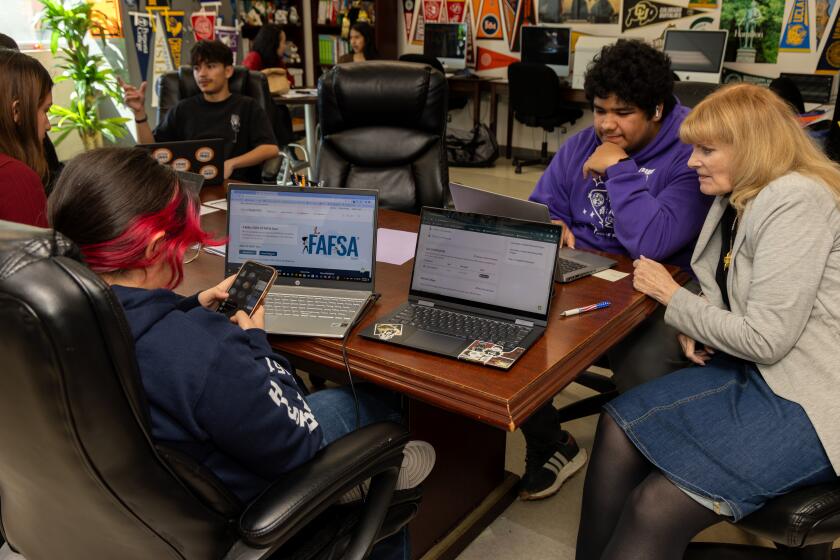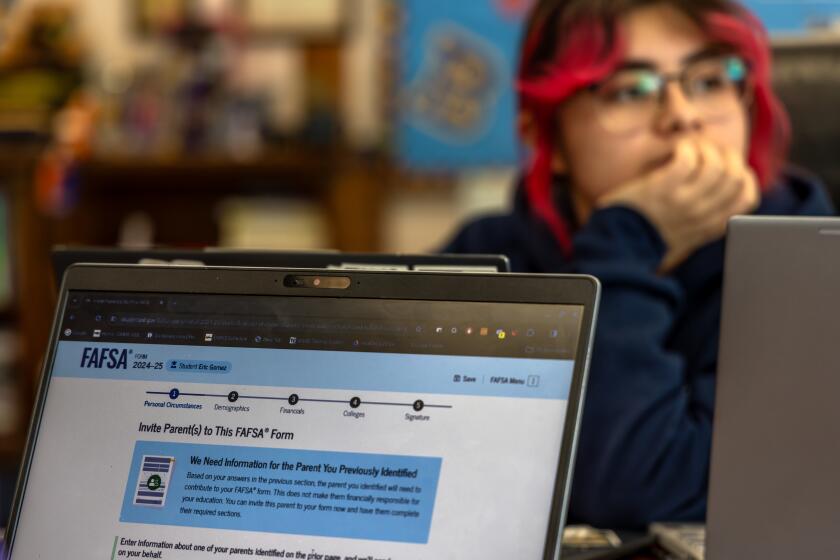Struggling to get help with college through the FAFSA? Here’s why you shouldn’t give up

- Share via
Applying to college and navigating the financial aid process is never easy, especially for first-generation students. But this year has been unusually challenging because of problems with the rollout of the new Free Application for Federal Student Aid, or FAFSA.
As the leader of an organization working to ensure that California students get the financial aid that will allow them to achieve their college dreams, I’m deeply concerned that so many students and families have been struggling to complete their applications. California is experiencing a precipitous drop in aid applications compared with last year, second only to Tennessee’s as of early March. The Times reported huge year-over-year declines in the number of L.A. area high school students completing their applications.
Online glitches have discouraged many from applying for federal student aid, but forcing low-income families to prove their neediness has bigger problems.
The problem has been especially dire for roughly 100,000 California student applicants with a parent or spouse who does not have a Social Security number, which is common among families that include relatively recent immigrants. For many months, it was impossible for these families to complete their applications. The U.S. Department of Education announced a solution for them last month, but the online application remains hard to navigate, and some families are still unable to apply.
It’s important for families across California to know that more solutions are in the works to help them obtain all the financial aid they deserve, including an extension of the financial aid deadline to May 2. Resources are available to help them complete their applications in the month ahead.
For students and families still dealing with the aid application, I have three key messages:
The rollout of the new, ‘simpler’ FAFSA application is unacceptably chaotic. There’s plenty of blame to go around.
Keep at it. The Free Application for Federal Student Aid is still the only path to the largest sources of federal aid to help you pay for college, and higher education institutions use the FAFSA to determine students’ eligibility for state and school aid. The U.S. Department of Education has been working to fix the glitches that prevented many families from completing the application. So if you have yet to fill out your form, do it now, and remember that both students and parents need to complete the relevant sections.
Complete the California Dream Act application if you’re eligible. The application is available to undocumented students, recipients of Deferred Action for Childhood Arrivals, those with temporary protected status and others. It can open the door to additional financial aid resources to further reduce the cost of college.
Reach out for help. Many resources are available for students and families who encounter problems with their applications, including:
- The financial aid offices at the colleges where you’re applying. If you’re having problems or your application has been delayed, let the colleges know.
- Your high school counselors, teachers and college access organizations such as mine.
- Free Cash for College webinars from the California Student Aid Commission, which make financial aid experts available to answer questions about financial aid. Or watch one of the commission’s prerecorded Cash for College videos.
- Tools for students and families such as the commission’s Cali chatbot and uAspire’s how-to videos.
- The federal government’s student aid Help Center.
In the months ahead, the Department of Education will be getting plenty of advice about how to ensure a much smoother and easier process next year. When the application is functioning properly, it streamlines the financial aid process, and direct transfers of IRS tax information to the form have improved. This gives us hope that the application experience will be better next year and beyond.
Right now, however, we’re encouraging students and families to stay focused on pursuing their college dreams. A bachelor’s degree remains the surest path to higher incomes and greater economic mobility, especially for students from lower-income families. Financial aid is available, you have earned it, and to the extent that you are eligible, I’m confident you will receive it. You just may need a little more time and help getting it this year.
Jaclyn Piñero is the chief executive of uAspire, a nonprofit dedicated to improving the economic mobility of underrepresented students.
More to Read
A cure for the common opinion
Get thought-provoking perspectives with our weekly newsletter.
You may occasionally receive promotional content from the Los Angeles Times.











